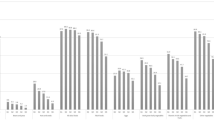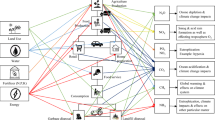Abstract
There is considerable controversy as to whether a healthy diet is affordable given recent inflation. In order to determine whether a healthy, climate-friendly sustainable diet can be obtained within the allotments of the Supplemental Nutrition Assistance Program (SNAP), we created and purchased 26 weeks of meal plans designed to meet the EAT-Lancet sustainability guidelines and > 90% of the RDAs for 23 macro/micronutrients for households with at least 2 adults and 1–3 children. We compared the food quantities and cost of a healthy sustainable diet purchased in Los Angeles, 2023, to the Thrifty Food Plan, 2021. We compared the volume of food and cost of basic groceries to those recommended in the Thrifty Food Plan, 2021. The costs of the sustainable diet fell within the 2023 SNAP allotments as long as the average calories required per person did not exceed 2000. The volume of fruits, vegetables, legumes, nuts, and seeds were considerably higher for the sustainable diet compared to the Thrifty Food Plan. Given that calorie needs are the determinants of food quantity and costs, the USDA may consider offering supplemental coverage for individuals with higher calorie needs to make healthy eating affordable.
Similar content being viewed by others
Data Availability
Data available upon request.
References
Dixon KA, Michelsen MK, Carpenter CL. Modern diets and the health of our planet: an investigation into the environmental impacts of food choices. Nutrients. 2023;15(3). https://doi.org/10.3390/nu15030692.
Koch CA, Sharda P, Patel J, Gubbi S, Bansal R, Bartel MJ. Climate change and obesity. Horm Metab Res. 2021;53(9):575–87. https://doi.org/10.1055/a-1533-2861.
Willett W, Rockstrom J, Loken B, et al. Food in the Anthropocene: the EAT-Lancet Commission on healthy diets from sustainable food systems. Lancet. 2019;393(10170):447–92. https://doi.org/10.1016/S0140-6736(18)31788-4.
(CNPP) U. Thrifty Food Plan, 2021. In: FNS-916 ed: USDA; 2021.
USDA. Supplemental Nutrition Assistance Program (SNAP) Fiscal Year (FY) 2024 Maximum Allotments and Deductions. In: USDA; 2023.
Cohen DA, Estrada EL, Montes M, et al. Food prescription pilots: feasibility, acceptability and affordability of improving diet through menu planning and grocery delivery. J Hum Nutr Diet. 2023. https://doi.org/10.1111/jhn.13142.
Cohen DA, Bogart L, Castro G, Rossi AD, Williamson S, Han B. Beverage marketing in retail outlets and The Balance Calories Initiative. Prev Med. 2018;115:1–7. https://doi.org/10.1016/j.ypmed.2018.07.014.
Cohen DA, Babey SH. Contextual influences on eating behaviours: heuristic processing and dietary choices. Obes Rev. 2012;13(9):766–79. https://doi.org/10.1111/j.1467-789X.2012.01001.x.
Zimmerman FJ. Using marketing muscle to sell fat: the rise of obesity in the modern economy. Annu Rev Public Health. 2011;32:285–306.
Kraak V, Rincon-Gallardo Patino S, Renukuntla D, Kim E. Progress evaluation for transnational restaurant chains to reformulate products and standardize portions to meet healthy dietary guidelines and reduce obesity and non-communicable disease risks, 2000–2018: a scoping and systematic review to inform policy. Int J Environ Res Public Health. 2019;16(15).https://doi.org/10.3390/ijerph16152732.
Diliberti N, Bordi PL, Conklin MT, Roe LS, Rolls BJ. Increased portion size leads to increased energy intake in a restaurant meal. Obes Res. 2004;12(3):562–8.
Young LR, Nestle M. Expanding portion sizes in the US marketplace: implications for nutrition counseling. J Am Diet Assoc. 2003;103(2):231–4.
Berthy F, Brunin J, Alles B, et al. Higher adherence to the EAT-Lancet reference diet is associated with higher nutrient adequacy in the NutriNet-Sante cohort: a cross-sectional study. Am J Clin Nutr. 2023;117(6):1174–85. https://doi.org/10.1016/j.ajcnut.2023.03.029.
Sofi F, Macchi C, Abbate R, Gensini GF, Casini A. Mediterranean diet and health status: an updated meta-analysis and a proposal for a literature-based adherence score. Public Health Nutr. 2014;17(12):2769–82. https://doi.org/10.1017/S1368980013003169.
Wang Y, Liu B, Han H, et al. Associations between plant-based dietary patterns and risks of type 2 diabetes, cardiovascular disease, cancer, and mortality - a systematic review and meta-analysis. Nutr J. 2023;22(1):46. https://doi.org/10.1186/s12937-023-00877-2.
Collaborators GBDO, Afshin A, Forouzanfar MH, et al. Health effects of overweight and obesity in 195 countries over 25 years. N Engl J Med. 2017;377(1):13–27. https://doi.org/10.1056/NEJMoa1614362.
Derbyshire EJ. Flexitarian diets and health: a review of the evidence-based literature. Front Nutr. 2016;3:55. https://doi.org/10.3389/fnut.2016.00055.
Budhathoki S, Sawada N, Iwasaki M, et al. Association of animal and plant protein intake with all-cause and cause-specific mortality in a Japanese cohort. JAMA Intern Med. 2019;179(11):1509–18. https://doi.org/10.1001/jamainternmed.2019.2806.
Peters BA, Xing J, Chen GC, et al. Healthy dietary patterns are associated with the gut microbiome in the Hispanic Community Health Study/Study of Latinos. Am J Clin Nutr. 2023;117(3):540–52. https://doi.org/10.1016/j.ajcnut.2022.11.020.
Funding
This work is funded by the NIMHD #P50MD017344. The sponsors had no role in the study design; collection, analysis, interpretation of data, or writing of the report and the supporting source had no involvement or restrictions regarding publication.
Author information
Authors and Affiliations
Corresponding author
Additional information
Publisher's Note
Springer Nature remains neutral with regard to jurisdictional claims in published maps and institutional affiliations.
Rights and permissions
Springer Nature or its licensor (e.g. a society or other partner) holds exclusive rights to this article under a publishing agreement with the author(s) or other rightsholder(s); author self-archiving of the accepted manuscript version of this article is solely governed by the terms of such publishing agreement and applicable law.
About this article
Cite this article
Cohen, D.A., Puttock, E., Montes, M. et al. An Affordable and Sustainable Thrifty-Like Meal Plan, FoodRx, That Meets the Recommended Dietary Allowances. J Urban Health 101, 364–370 (2024). https://doi.org/10.1007/s11524-024-00843-1
Published:
Issue Date:
DOI: https://doi.org/10.1007/s11524-024-00843-1




